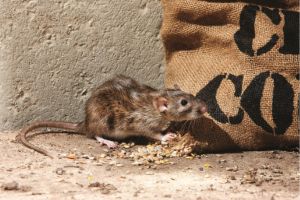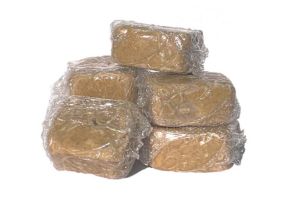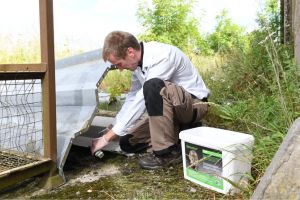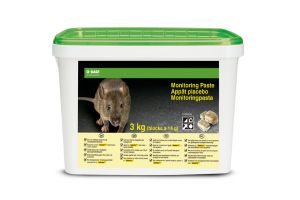Monitoring Paste: A must-have for rural rodent control
Every farmer will be all too familiar with the challenges of tackling tricky rodent infestations and rural rodent control, whether it’s rats or mice causing the issue. Farms are the perfect haven for rodents, with an abundance of food sources, access to water, and plenty of harbourages to shelter and nest in.
 On top of that, farmers have to compete with issues such as neophobia, behavioural resistance, rodenticide resistance, and environmental factors, making gaining control a time-consuming and potentially costly affair.
On top of that, farmers have to compete with issues such as neophobia, behavioural resistance, rodenticide resistance, and environmental factors, making gaining control a time-consuming and potentially costly affair.
One of the most under-utilised tools in a farmer’s armoury, though, is monitoring bait. Usually formulated (although not exclusive) to blocks, non-toxic baits are made from a blend of food-grade ingredients that rodents find attractive.
In years gone by, and perhaps to an extent still to this day, the use of monitoring products has been considered a waste of time and money by many farmers and only used when required by auditors. However, as time moves on and farmers become more considerate of rodenticide use, many are now discovering the numerous benefits of adding monitoring products to their Integrated Pest Management (IPM) programme.
So, what are the benefits of using a monitoring bait?
-
Detect infestations early
Monitoring products are key to helping farmers detect early signs of rodent activity and get ahead of potentially challenging infestations. Previously, farmers may have simply relied on discovering physical evidence such as droppings, runs and signs of damage, when carrying out site inspections. Some may even use tracking dust or sand along suspected activity areas.
 But when an infestation is just taking hold, and little may be noticed through a visual inspection, the use of non-toxic monitoring products allows farmers to easily track rodent activity and determine the extent of the infestation.
But when an infestation is just taking hold, and little may be noticed through a visual inspection, the use of non-toxic monitoring products allows farmers to easily track rodent activity and determine the extent of the infestation.
Monitoring blocks, such as Monitoring Paste by BASF, act as a first indicator that a site has early signs of rodent activity, with rats and mice making the most of having a highly palatable and easily accessible food source on hand. This allows farmers to act fast, and gain control before it becomes established.
-
Prevents the need for permanent baiting
In many cases, a lot of farmers choose to permanently bait, believing that this approach will prevent an infestation from taking hold. These actions from an environmental perspective can be difficult to justify, and also very costly.
What’s more, there aren’t many circumstances where farmers and professional pest controllers alike can legitimately permanently bait, and in what situations, to pass auditing. Only certain products containing Bromadiolone, Difenacoum and Cholecalciferol (Selontra) products have been authorised for use in permanent baiting. However, the older anticoagulants are now thought to be less effective due to an increase in rodenticide resistance.
Using a monitoring bait when rodent activity is less likely, such as in the warmer summer months, means farmers can still monitor and detect early activity, without the need to use chemical control and without causing unnecessary risk to non-target species as outlined in the CRRU Code of Best Practice.
-
Monitoring encourages rodenticide uptake
 Rodents are notorious for being wary of new objects in their environment, so putting a rodenticide down when early activity is detected can result in a delayed take. By using monitoring baits, rodents in the area will become more familiar with the object, reducing neophobia when the monitoring baits are replaced with rodenticide, should a chemical control method be required.
Rodents are notorious for being wary of new objects in their environment, so putting a rodenticide down when early activity is detected can result in a delayed take. By using monitoring baits, rodents in the area will become more familiar with the object, reducing neophobia when the monitoring baits are replaced with rodenticide, should a chemical control method be required.
Using a monitoring block that has a ‘sister’ toxic product will ensure you get rapid control if an issue occurs. Monitoring Paste by BASF features a non-toxic soft block formulation that is based on the highly palatable, award-winning rodenticide Selontra®, with the active and dye taken out.
This approach to monitoring can mean your treatment time is massively reduced comparatively from starting from scratch or using alternative products.
-
Save money on wasted bait
Before an infestation takes hold, it can be difficult to know exactly where rodents may come from and how they may move around a site, which can make baiting in all boxes tempting. Over time though, if there is no activity on site, the farmer will still have to replace the rodenticide as it will start to go mouldy and be unappealing to rodents, or worse be demolished by slugs and snails.
By using monitoring blocks at these sites, rodents will readily eat them if they appear, giving an early indication, and if they don’t appear then the cost of replacing mouldy monitoring blocks is insignificant compared to its toxic counterpart.

-
Target your baiting programme
Plenty of farmers will experience repeated activity usually around the same areas of the site. By changing their approach to monitoring and having toxic bait in situ at those regularly affected areas, as opposed to all around the site, they can target their treatment appropriately rather than blanket treating. This methodology can allow farmers to employ a more targeted approach when treating an infestation, whilst saving them money and reducing the exposure of non-target rodent species, as per the CRRU guidance.
For more expert advice on rural rodent control, and to find out more about BASF’s rodent control solutions, visit https://www.pestcontrol.basf.co.uk/en/Urban-and-Rural-Pest-Control/Rural-Pest-Control/
Read our similar article from BASF: 'How farmers can ensure they pass their pest control audits.'
- Log in to post comments

